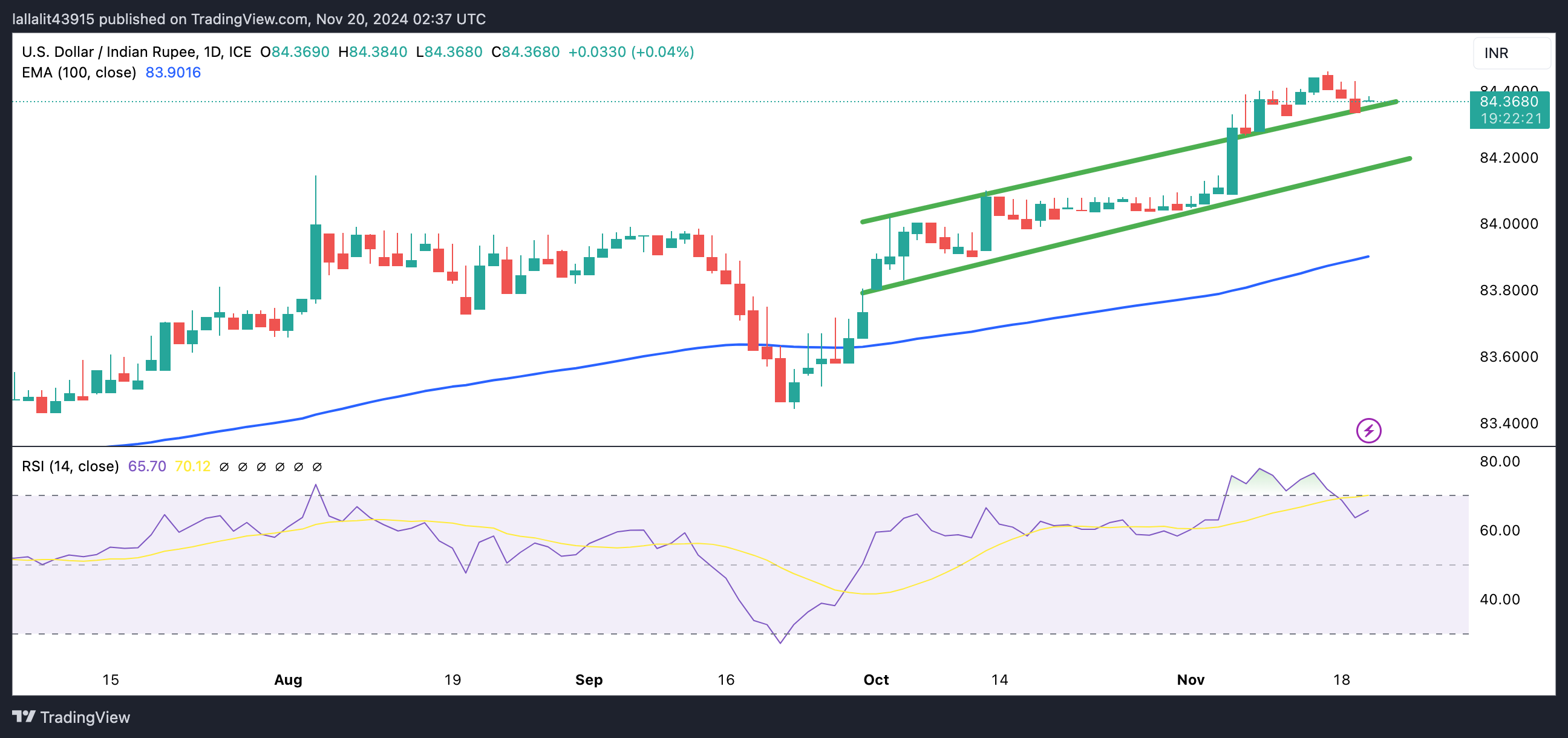- The Indian Rupee softens in Wednesday’s early European session.
- Sustained portfolio outflows and geopolitical risks could weigh on the INR, but RBI interventions might cap its downside.
- Investors await the speeches from the Fed’s Cook and Bowman on Wednesday.
The Indian Rupee (INR) loses traction on Wednesday. The local currency remains under some selling pressure due to the renewed US Dollar (USD) demand from importers and rising geopolitical tensions after Russian officials said that Ukraine used US ATACMS missiles to strike Russian territory for the first time, while Russian President Vladimir Putin approved an updated nuclear doctrine.
Furthermore, sustained portfolio outflows contribute to the INR’s downside. However, any significant depreciation of the Indian Rupee might be limited as the Reserve Bank of India (RBI) is likely to sell the USD to support the INR.
In the absence of top-tier economic data released from the US and India, the USD price dynamics will continue to play a key role in influencing the pair. The Federal Reserve (Fed) Lisa Cook and Michelle Bowman are scheduled to speak later on Wednesday.
Indian Rupee remains weak amid mounting geopolitical tensions
- "Mild weakness in the dollar will not lead to any major appreciation in the rupee because the RBI will look to replenish its foreign exchange reserves, but if the dollar index moves 2-3% lower, we may see half a per cent of move (in the rupee)," noted Nitin Agarwal, head of treasury at ANZ India.
- Foreign Portfolio Investment (FPI) inflows into India are estimated to remain positive in FY25, with an expected inflow of USD 20-25 billion, according to the Bank of Baroda.
- Markets have pared bets for a 25 basis points (bps) interest-rate cut at the December meeting to less than 59%, down from 76.8% a month ago, according to the CME FedWatch Tool.
- The US Building Permits declined by 0.6% from 1.425 million to 1.416 million in October. Meanwhile, Housing Starts fell by 3.1% from 1.353 million to 1.311 million during the same period.
- Kansas City Fed President Jeffrey Schmid said it remains uncertain how far interest rates can fall, but the recent cuts by the Fed indicate confidence that inflation is heading toward its 2% target.
USD/INR’s bullish outlook remains in play
The Indian Rupee weakens on the day. However, the constructive view of the USD/INR pair remains intact, with the price holding above the ascending channel throwback support on the daily chart. The upward momentum of the pair is reinforced by the 14-day Relative Strength Index (RSI), which stands above the midline near 65.55, suggesting that the path of least resistance remains to the upside.
The all-time high of 84.45 acts as an immediate resistance level for USD/INR. A break above this level could pave the way to the 85.00 psychological level.
In the bearish case, any follow-through selling below the resistance-turned-support level at 84.35 could be enough to attract some sellers and take the pair back down to the 84.00-83.90 region, representing the round mark and the 100-day EMA.
Indian Rupee FAQs
The Indian Rupee (INR) is one of the most sensitive currencies to external factors. The price of Crude Oil (the country is highly dependent on imported Oil), the value of the US Dollar – most trade is conducted in USD – and the level of foreign investment, are all influential. Direct intervention by the Reserve Bank of India (RBI) in FX markets to keep the exchange rate stable, as well as the level of interest rates set by the RBI, are further major influencing factors on the Rupee.
The Reserve Bank of India (RBI) actively intervenes in forex markets to maintain a stable exchange rate, to help facilitate trade. In addition, the RBI tries to maintain the inflation rate at its 4% target by adjusting interest rates. Higher interest rates usually strengthen the Rupee. This is due to the role of the ‘carry trade’ in which investors borrow in countries with lower interest rates so as to place their money in countries’ offering relatively higher interest rates and profit from the difference.
Macroeconomic factors that influence the value of the Rupee include inflation, interest rates, the economic growth rate (GDP), the balance of trade, and inflows from foreign investment. A higher growth rate can lead to more overseas investment, pushing up demand for the Rupee. A less negative balance of trade will eventually lead to a stronger Rupee. Higher interest rates, especially real rates (interest rates less inflation) are also positive for the Rupee. A risk-on environment can lead to greater inflows of Foreign Direct and Indirect Investment (FDI and FII), which also benefit the Rupee.
Higher inflation, particularly, if it is comparatively higher than India’s peers, is generally negative for the currency as it reflects devaluation through oversupply. Inflation also increases the cost of exports, leading to more Rupees being sold to purchase foreign imports, which is Rupee-negative. At the same time, higher inflation usually leads to the Reserve Bank of India (RBI) raising interest rates and this can be positive for the Rupee, due to increased demand from international investors. The opposite effect is true of lower inflation.
Information on these pages contains forward-looking statements that involve risks and uncertainties. Markets and instruments profiled on this page are for informational purposes only and should not in any way come across as a recommendation to buy or sell in these assets. You should do your own thorough research before making any investment decisions. FXStreet does not in any way guarantee that this information is free from mistakes, errors, or material misstatements. It also does not guarantee that this information is of a timely nature. Investing in Open Markets involves a great deal of risk, including the loss of all or a portion of your investment, as well as emotional distress. All risks, losses and costs associated with investing, including total loss of principal, are your responsibility. The views and opinions expressed in this article are those of the authors and do not necessarily reflect the official policy or position of FXStreet nor its advertisers. The author will not be held responsible for information that is found at the end of links posted on this page.
If not otherwise explicitly mentioned in the body of the article, at the time of writing, the author has no position in any stock mentioned in this article and no business relationship with any company mentioned. The author has not received compensation for writing this article, other than from FXStreet.
FXStreet and the author do not provide personalized recommendations. The author makes no representations as to the accuracy, completeness, or suitability of this information. FXStreet and the author will not be liable for any errors, omissions or any losses, injuries or damages arising from this information and its display or use. Errors and omissions excepted.
The author and FXStreet are not registered investment advisors and nothing in this article is intended to be investment advice.
Recommended content
Editors’ Picks

EUR/USD retreats below 1.0900 after US inflation data
EUR/USD stays under modest bearish pressure and trades below 1.0900 in the American session on Wednesday. Despite the softer-than-forecast February inflation data from the US, the US Dollar clings to daily recovery gains and makes it difficult for the pair to regain its traction.

Gold maintains its narrow range above $2,900 following US inflation
Prices of Gold remain slightly bid following February’s US inflation readings, hovering around the $2,920 zone against the backdrop of a mild bid bias in the US Dollar and lower yields across the board. Markets remain focused on trade war headlines.

GBP/USD pulls away from multi-month highs, holds above 1.2900
After rising toward 1.3000 earlier in the day, GBP/USD struggles to hold its ground and trades below 1.2950 on Wednesday. The improving risk mood following the February US CPI data, however, helps the pair limit its losses.

Bitcoin, XRP and Solana slump with US stock sell-off, Lummis eyes 1 million BTC purchase
Bitcoin (BTC), XRP and Solana (SOL) prices struggle on Wednesday. The three tokens rank in the top 5 cryptocurrencies by market capitalization, and the risk-off sentiment in the crypto market has ushered in a cooling-off period.

Gold maintains its narrow range above $2,900 following US inflation
Prices of Gold remain slightly bid following February’s US inflation readings, hovering around the $2,920 zone against the backdrop of a mild bid bias in the US Dollar and lower yields across the board. Markets remain focused on trade war headlines.

The Best brokers to trade EUR/USD
SPONSORED Discover the top brokers for trading EUR/USD in 2025. Our list features brokers with competitive spreads, fast execution, and powerful platforms. Whether you're a beginner or an expert, find the right partner to navigate the dynamic Forex market.
